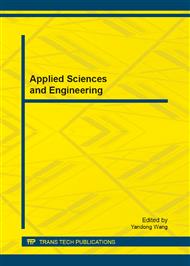[1]
J. -M. Kwon, K. -H. Nam, B. -H. Kwon, Photovoltaic Power Conditioning System With Line Connection, Trans. On Industrial Electronics, vol. 53, no. 4, pp.1048-1054, June (2006).
DOI: 10.1109/tie.2006.878329
Google Scholar
[2]
Yeong-Chau Kuo, Tsorng-Juu Liang, Jiann-Fuh Chen, A high-efficiency single-phase three-wire photovoltaic energy conversion system, Trans. On Industrial Electronics, vol. 50, no. 1, pp.116-122, Feb. (2003).
DOI: 10.1109/tie.2002.807252
Google Scholar
[3]
Nobuyoshi Mutoh, Takayoshi Inoue, A Control Method to Charge Series-Connected Ultraelectric Double-Layer Capacitors Suitable for Photovoltaic Generation Systems Combining MPPT Control Method, Trans. On Industrial Electronics, vol. 54, no. 1, pp.374-383, Feb. (2007).
DOI: 10.1109/tie.2006.885149
Google Scholar
[4]
W. Xiao, W. G. Dunford, P. R. Palmer, A. Capel, Application of Centered Differentiation and Steepest Descent to Maximum Power Point Tracking, Trans. On Industrial Electronics, vol. 54, no. 4, pp.2539-2549, Aug (2007).
DOI: 10.1109/tie.2007.899922
Google Scholar
[5]
C. -T. Pan, J. -Y. Chen, C. -P. Chu, and Y. -S. Huang, A fast maximum power point tracker for photovoltaic power systems, in Proc. IEEE IECON, San Jose, CA, vol. 1, p.390–393.
DOI: 10.1109/iecon.1999.822229
Google Scholar
[6]
W. Xiao, M.G.J. Lind, W.G. Dunford, A. Capel, Real-Time Identification of Optimal Operating Points in Photovoltaic Power Systems, Trans. On Industrial Electronics, vol. 53, no. 4, pp.1017-1026, June (2006).
DOI: 10.1109/tie.2006.878355
Google Scholar
[7]
Development of a suitable model for characterizing photovoltaic arrays with shaded solar cells Solar Energy Volume: 81, Issue: 8, August, 2007, pp.977-992.
DOI: 10.1016/j.solener.2006.12.001
Google Scholar
[8]
Woyte, A., Nijs, J., Belmans, R., 2003. Partial shadowing of photovoltaic arrays with different system configurations: literature review and field test results. Solar Energy 74, 217–233.
DOI: 10.1016/s0038-092x(03)00155-5
Google Scholar
[9]
G. Velasco, J.J. Negroni, F. Guinjoan and R. Piqué. Irradiance Equalization Method for Output Power Optimization in Plant Oriented Grid-Connected PV Generators, 11th European Conference on Power Electronics and Applications, 2005. (EPE 05). Dresden (Germany), September (2005).
DOI: 10.1109/epe.2005.219300
Google Scholar
[10]
Auttawaitkul, Y.; Pungsiri, B.; Chammongthai, K.; Okuda, M.; A method of appropriate electrical array reconfiguration management for photovoltaic powered car, Circuits and Systems, 1998. IEEE APCCAS 1998. The 1998 IEEE Asia-Pacific Conference on 24-27 Nov. 1998 Page(s): 201 – 204.
DOI: 10.1109/apccas.1998.743713
Google Scholar
[11]
Salameh, Z.M.; Liang, C. Optimum switching points for array reconfiguration controller, Photovoltaic Specialists Conference, 1990., Conference Record of the Twenty First IEEE Volume , Issue , 21-25 May 1990 Page(s): 971 – 976 vol. 2.
DOI: 10.1109/pvsc.1990.111762
Google Scholar
[12]
Candela, R.; Di Dio, V.; Riva Sanseverino, E.; Romano, P.; Reconfiguration Techniques of Partial Shaded PV Systems for the Maximization of Electrical Energy Production" International Conference on Clean Electrical Power, 2007. ICCEP , 07. 21-23 May 2007 Page(s): 716 – 719.
DOI: 10.1109/iccep.2007.384290
Google Scholar
[13]
G. Velasco, J.J. Negroni, F. Guinjoan and R. Piqué. Energy Generation in PV Grid-Connected Systems: A Comparative Study Depending on the PV Generator Configuration'. IEEE International Symposium on Industrial Electronics, 2005. (ISIE 05). Vol. 3, páginas 1025 - 1030. Dubrovnik (Croatia), June 2005.K. Elissa, "Title of paper if known, unpublished.
DOI: 10.1109/isie.2005.1529064
Google Scholar
[14]
Charles G. Wright: Simulation of Solar Cell Properties with Electronic Circuit Simulation Software, Chuck Wright Consulting LLC, Round Rock, Texas.
Google Scholar
[15]
Gregg, T. Parker, R. Swenson: A real world examination of PV system design and performances, 31th IEEE Photovoltaic Specialists Conference, Orlando (2005).
DOI: 10.1109/pvsc.2005.1488448
Google Scholar
[16]
N. J. C. M. van der Borg, M. J. Jansen: Energy loss due to shading in a BIPV application, 3rd Word Conference on Photovoltaic Energy Conversion, Osaka, Japan May 11-18 (2000).
Google Scholar
[17]
G. Velasco-Quesada, F. Guinjoan-Gispert, R. Pique-Lopez, M. Roman-Lumbreras, A. Conesa-Roca; Industrial Electronics: Electrical PV Array Reconfiguration Strategy for Energy Extraction Improvement in Grid-Connected PV Systems,. IEEE Transactions onVolume: 56, Issue: 11Digital Object Identifier: 10. 1109/TIE. 2009. 2024664 Publication Year: 2009.
DOI: 10.1109/tie.2009.2024664
Google Scholar



